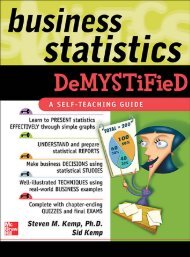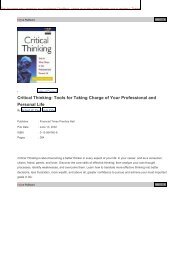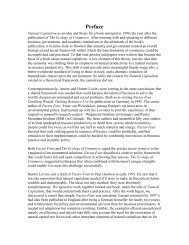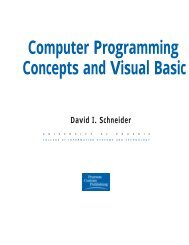Chapter 06 - Changing Education Paradigm
Chapter 06 - Changing Education Paradigm
Chapter 06 - Changing Education Paradigm
You also want an ePaper? Increase the reach of your titles
YUMPU automatically turns print PDFs into web optimized ePapers that Google loves.
12 CHAPTER 6. MINING ASSOCIATION RULES IN LARGE DATABASES<br />
The basic idea of the sampling approach istopick a random sample S of the given data D, and then search<br />
for frequent itemsets in S instead D. In this way, we trade o some degree of accuracy against e ciency. The<br />
sample size of S is such that the search for frequent itemsets in S can be done in main memory, and so, only<br />
one scan of the transactions in S is required overall. Because we are searching for frequent itemsets in S rather<br />
than in D, it is possible that we will miss some of the global frequent itemsets. To lessen this possibility, we<br />
use a lower support threshold than minimum support to nd the frequent itemsets local to S (denoted L S ).<br />
The rest of the database is then used to compute the actual frequencies of each itemset in L S . A mechanism<br />
is used to determine whether all of the global frequent itemsets are included in L S . If L S actually contained<br />
all of the frequent itemsets in D, then only one scan of D was required. Otherwise, a second pass can be done<br />
in order to nd the frequent itemsets that were missed in the rst pass. The sampling approach is especially<br />
bene cial when e ciency is of utmost importance, such as in computationally intensive applications that must<br />
be run on a very frequent basis.<br />
6. Dynamic itemset counting: Adding candidate itemsets at di erent points during a scan.<br />
A dynamic itemset counting technique was proposed in which the database is partitioned into blocks marked by<br />
start points. In this variation, new candidate itemsets can be added at any start point, unlike in Apriori, which<br />
determines new candidate itemsets only immediately prior to each complete database scan. The technique<br />
is dynamic in that it estimates the support of all of the itemsets that have been counted so far, adding new<br />
candidate itemsets if all of their subsets are estimated to be frequent. The resulting algorithm requires two<br />
database scans.<br />
7. Calendric market basket analysis: Finding itemsets that are frequent in a set of user-de ned time intervals.<br />
Calendric market basket analysis uses transaction time stamps to de ne subsets of the given database. An<br />
itemset that does not satisfy minimum support may be considered frequent with respect to a subset of the<br />
database which satis es user-speci ed time constraints.<br />
8. Sequential patterns: Finding sequences of transactions associated over time.<br />
The goal of sequential pattern analysis is to nd sequences of itemsets that many customers have purchased in<br />
roughly the same order. A transaction sequence is said to contain an itemset sequence if each itemset is<br />
contained in one transaction, and the following condition is satis ed: If the ith itemset in the itemset sequence<br />
is contained in transaction j in the transaction sequence, then the (i + 1)th itemset in the itemset sequence is<br />
contained in a transaction numbered greater than j. The support of an itemset sequence is the percentage of<br />
transaction sequences that contain it.<br />
Other variations involving the mining of multilevel and multidimensional association rules are discussed in the<br />
rest of this chapter. The mining of time sequences is further discussed in <strong>Chapter</strong> 9.<br />
6.3 Mining multilevel association rules from transaction databases<br />
6.3.1 Multilevel association rules<br />
For many applications, it is di cult to nd strong associations among data items at low or primitive levels of<br />
abstraction due to the sparsity of data in multidimensional space. Strong associations discovered at very high<br />
concept levels may represent common sense knowledge. However, what may represent common sense to one user,<br />
may seem novel to another. Therefore, data mining systems should provide capabilities to mine association rules at<br />
multiple levels of abstraction and traverse easily among di erent abstraction spaces.<br />
Let's examine the following example.<br />
Example 6.3 Suppose we are given the task-relevant set of transactional data in Table 6.1 for sales at the computer<br />
department ofanAllElectronics branch, showing the items purchased for each transaction TID. The concept hierarchy<br />
for the items is shown in Figure 6.8. A concept hierarchy de nes a sequence of mappings from a set of low level<br />
concepts to higher level, more general concepts. Data can be generalized by replacing low level concepts within the<br />
data by their higher level concepts, or ancestors, from a concept hierarchy 4 . The concept hierarchy of Figure 6.8 has<br />
4 Concept hierarchies were described in detail in <strong>Chapter</strong>s 2 and 4. In order to make the chapters of this book as self-contained as<br />
possible, we o er their de nition again here. Generalization was described in <strong>Chapter</strong> 5.










